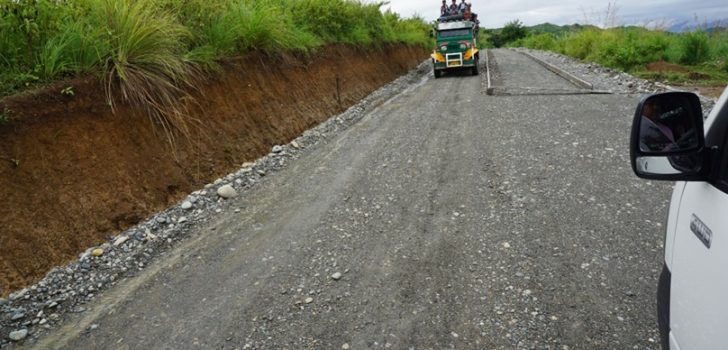
Emerging benefits already seen in ongoing DA-PRDP subprojects in Kalinga
Residents of affected barangays of the two pilot farm-to-market roads (FMRs) currently being concreted in Kalinga claim apparent benefits of said subprojects while still ongoing.
Mary Ann Macaso, an active barangay official and a beneficiary of the 13-kilometer Banneng-Gombowoy FMR, said that the ongoing construction of the road already proves beneficial to the residents in several ways.
“Adon iti mariknam nga pagyamanan itatta pailaeng nga masemsemento iti kalsada mi tani adun ti mailako, nalaka da laeng nga maitransport ta ada iti kaslsada nga nasemento uray puted-puted ket at least nga inaldaw-aldaw nga rumwar iti produkto da ditoy (We are already experiencing several benefits as early as now that our road is being concreted. Like when we have crops to sell, difficulty in transporting has lessened even if the roads being concreted are still incomplete. At least we can now bring our products to the market on a daily basis),” narrates Macaso.
She added that aside from coffee, other major products are being transported from far-flung areas in Tanudan like corn, banana, rice and other marketable products which will help increase the income of the farmers as long as transporting problems are mitigated.
Passing through the same road are the women members of the Tanudan Savings and Lending Cooperative (TASALECO), whose members claim that many women are forced to work abroad due to lack of income generating activities in their area. “With the improvement of our roads, we also expect economic improvement through the rise of the coffee industry and other businesses in our area. By then, less women will work abroad as domestic helpers,” they said.
Meanwhile, beneficiaries of the 15.8-kilometer Bulanao-Amlao FMR coming from the farthest part of the area having access through the nearby Chico River, say they prefer to pass through the road because transporting coffee and other crops through the river is more expensive, tedious and costly, not to mention the danger in passing through rivers during typhoons.
“Transporting our goods to the market takes five movers,” said Mr. Esteban Dumaguing, resident of Barangay Amlao. “This means you have to pay haulers five times. Whereas, if we use the road, hauling fee is reduced because there are only two moves involved. One for hauling to the jeepney, and another to haul the products to the market,” he said.
Dumaguing added that they use to rather dump their products in their backyards and leave them to rot or fed to the pigs because they do not gain anything by bringing their products to the market due to poor or almost zero access to the market. Accordingly, this discouraged them to take care of their coffee plantations. However, with the ongoing concreting, new rays of hope have fallen into the residents.
“Now that cementing has commenced, we started to visit our coffee plantations to do some cleaning and maintenance because this is one of the biggest source of income for us here in Amlao,” Dumaguing added.
Easier access to the hospital is also one major benefit that is mentioned by the beneficiaries.
“Traversing the river used to be our means of reaching the market in Tabuk City. However, many people already died passing through it. We use this route to bring our sick to the hospital because it’s nearer, but it’s very dangerous. In times of emergencies, we cannot go across because or rafts topple over causing more accidents. We therefore prefer to pass through the long road to the City”.
Travel time has decreased from around one hour to about 40 minutes with a part of the Bulanao-Amlao road being concreted”, said Marcelino Addatu, jeepney driver. “We use to do only one or two back and forth trip because of the difficult road, but now that this is being concreted, we do two round trips a day,a t most, three”, he added.
Addatu also speculates the possible lowering of transportation cost because of the lessened time and ease in transporting people and goods to and from the adjacent barangays of the FMR.
Unintended benefits are already apparent in the areas. The dried up roads are already used as drying pavements for rice and corn, children can go to school mud-free, and some banana producers may now bring their own products directly to the market for a higher selling price compared when traders buy it directly from their backyards.
Proposed under the Infrastructure Development (I-BUILD) Component of the PRDP, the two FMRs were constructed to develop a strategic network of climate-resilient rural infrastructure supportive of the value chain for coffee in the Province of Kalinga. (Mabel Zabala, RPCO-CAR InfoACE Unit)
